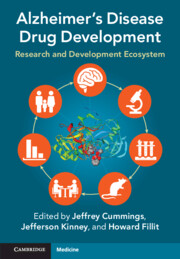Book contents
- Alzheimer’s Disease Drug Development
- Alzheimer’s Disease Drug Development
- Copyright page
- Dedication
- Contents
- Contributors
- Foreword
- Acknowledgments
- Section 1 Advancing Alzheimer’s Disease Therapies in a Collaborative Science Ecosystem
- Section 2 Non-clinical Assessment of Alzheimer’s Disease Candidate Drugs
- Section 3 Alzheimer’s Disease Clinical Trials
- Section 4 Imaging and Biomarker Development in Alzheimer’s Disease Drug Discovery
- 32 Development of Fluid Biomarkers for Alzheimer’s Disease
- 33 Brain Imaging for Alzheimer’s Disease Clinical Trials
- 34 Sharing of Alzheimer’s Disease Research Data in the Global Alzheimer’s Association Interactive Network
- 35 Pharmacogenetics in Alzheimer’s Disease Drug Discovery and Personalized Treatment
- 36 The Role of Electroencephalography in Alzheimer’s Disease Drug Development
- Section 5 Academic Drug-Development Programs
- Section 6 Public–Private Partnerships in Alzheimer’s Disease Drug Development
- Section 7 Funding and Financing Alzheimer’s Disease Drug Development
- Index
- References
33 - Brain Imaging for Alzheimer’s Disease Clinical Trials
from Section 4 - Imaging and Biomarker Development in Alzheimer’s Disease Drug Discovery
Published online by Cambridge University Press: 03 March 2022
- Alzheimer’s Disease Drug Development
- Alzheimer’s Disease Drug Development
- Copyright page
- Dedication
- Contents
- Contributors
- Foreword
- Acknowledgments
- Section 1 Advancing Alzheimer’s Disease Therapies in a Collaborative Science Ecosystem
- Section 2 Non-clinical Assessment of Alzheimer’s Disease Candidate Drugs
- Section 3 Alzheimer’s Disease Clinical Trials
- Section 4 Imaging and Biomarker Development in Alzheimer’s Disease Drug Discovery
- 32 Development of Fluid Biomarkers for Alzheimer’s Disease
- 33 Brain Imaging for Alzheimer’s Disease Clinical Trials
- 34 Sharing of Alzheimer’s Disease Research Data in the Global Alzheimer’s Association Interactive Network
- 35 Pharmacogenetics in Alzheimer’s Disease Drug Discovery and Personalized Treatment
- 36 The Role of Electroencephalography in Alzheimer’s Disease Drug Development
- Section 5 Academic Drug-Development Programs
- Section 6 Public–Private Partnerships in Alzheimer’s Disease Drug Development
- Section 7 Funding and Financing Alzheimer’s Disease Drug Development
- Index
- References
Summary
Imaging biomarkers are important in the diagnosis and evaluation of treatment effect in AD. The “A/T/N” (amyloid/tau/neurodegeneration) classification notably focused on disease characteristics measurable using imaging or CSF biomarkers. Information obtained with imaging biomarkers can address several challenges in AD trials, by confirming pathology for patient inclusion and target engagement, enabling stratification for analysis based on likely rate of clinical decline, and detecting treatment effect with fewer subjects; it also help to characterize treatment responders and to better understand the neurological basis for clinical response. This chapter discusses how imaging data are generated, the applicability of various imaging endpoints within the overall AD progression pathway, technical issues influencing the reliability and interpretability of the data, and practical steps to incorporate imaging into clinical trials. Applications of volumetric MRI, MRI used in safety assessment, amyloid PET, tau PET, and FDG PET measurement of glucose metabolism are described. Relevant regulatory guidance and the fit of imaging data with blood based or other biomarkers are discussed.
Keywords
- Type
- Chapter
- Information
- Alzheimer's Disease Drug DevelopmentResearch and Development Ecosystem, pp. 375 - 394Publisher: Cambridge University PressPrint publication year: 2022

